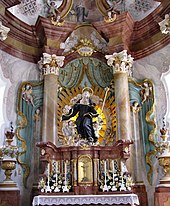St. Ottilia (Hellring)
The Roman Catholic pilgrimage church of St. Ottilia is a baroque hall church in the Hellring district of Langquaid in the Lower Bavarian district of Kelheim . It belongs to the parish of St. Michael in Paring in the diocese of Regensburg .
history
The church has been attested since the high Middle Ages in connection with an indulgence for church building granted in 1267 . During a complete restoration in the years 1987–1998 foundations and wall remains of various construction phases were found, the oldest of which probably belong to a Romanesque hall building. The tower and sacristy were rebuilt in 1720, the nave and choir in 1733–1735. The plans were probably submitted by the Landshut court architect Johann Georg Hirschstetter , the ceiling paintings are attributed to Otto Gebhard fromprüfunging, the stucco Martin Bader from Rohr .
The origin of the pilgrimage is not certain. Initially, it was looked after by the Augustinian monastery Paring , which had been subordinate to the Benedictine monastery of Andechs since 1598 . The new Baroque building of the pilgrimage church was commissioned by Abbot Maurus Braun from Andechs.
The legend of St. Odilia († 720) has been claimed since the 14th century by the Augustinian canons , but also by the Benedictines . According to legend, the daughter of an Alsatian duke , who was blind from birth and therefore cast out , received her sight through her baptism . As abbess, she had run a monastery she had founded.
architecture
The simple exterior is provided with rounded corners and is characterized by the imaginatively shaped windows, similar to a violin case, with lunette windows arranged above . The choir, which is only slightly drawn in, is closed in a semicircle. The tower, which is crowned with an octagonal superstructure and a constricted onion dome, is built on the north side . The superstructure is structured with kinked pilaster strips , dividing cornices and a cranked cornice.
The bright, friendly interior appears surprisingly spacious despite its moderate size. The local builder has adapted the simple room shape of a hall church with a retracted choir to the style ideals of the Rococo . Corresponding to the rounded corners of the nave and the end of the choir, the vaults are shaped like a basket . The choir vault is slightly lower than the ship's vault and thus makes the space more uniform. Pilasters with stucco capitals structure the walls. The lunette windows above the beams increase the amount of light.
The baptism of Ottilia by the traveling bishop Erhard von Regensburg is depicted in repeatedly renewed ceiling paintings with curly frames . In the nave there is a perspective domed hall in which the glorification of the saints is shown. Three peripheral fields in the choir are painted over with depictions of the life of the saints, the corresponding fields in the nave vault are empty.
The delicate, ornamental stucco decoration emphasizes the continuous vault shape without any stronger accents. It consists of ribbon and tendril work with grid fields. The window frames and the curved gallery parapet are also stuccoed, the latter particularly rich.
Furnishing
The high altar from 1735 is attributed to Martin Baader. It consists of a brick system that is fitted into the semicircular end of the choir, takes up the wall structure of the church and emphasizes and enhances it with reddish marbling and gilding . The mighty cranked beams are supported by four columns. The altar extension stuck to the vault frames the east of the smaller ceiling fields mentioned above. Behind the inner pair of pillars is a theater-like stucco curtain that is opened to reveal the yellow, oval choir apex window with a wreath of clouds and rays with putti . In front of it, Saint Ottilie is depicted in ecstatic movement as a carved figure, which is attributed to Franz Anton Neu fromprüfunging. Ottilia is shown with the black habit of the Augustinians, a putto shows her attribute, the open book with two eyes.
This magnificent complex is designed in the manner of the brothers Cosmas Damian and Egid Quirin Asam , but its architectural and figurative design is considerably more coarse. The development of the altar from the architectural structure of the room is comparable to Egid Quirin's creations in the Rohr monastery church .
The side altars were created around 1710 and consist of flat structures with protruding columns crowned with blown gables . The paintings from 1711 are by Johann Gebhard fromprüfunging and show the death of St. Benedict and the death of St. Scholastica . The pulpit was created around 1710 and features a painting and a bell figure from the 19th century. An altar wing from the late 15th century shows Saint Ottilia in relief in a renewed version .
organ
The organ is a work by Johann Konrad Brandenstein from around 1740 with seven stops on a manual and pedal , which was restored in 2002 by Ludwig and Wolfgang Eisenbarth . The disposition is:
|
|
|||||||||||||||||||||||||||
- Coupling : Pedal Coupler
literature
- Georg Dehio : Handbook of the German art monuments. Bavaria II - Lower Bavaria. Deutscher Kunstverlag, Munich, Berlin 2008, ISBN 978-3-422-03122-7 . Pp. 206-207.
Web links
Individual evidence
- ↑ Information about the organ on orgbase.nl. Retrieved July 28, 2019 .
Coordinates: 48 ° 51 '3.6 " N , 12 ° 3' 59.1" E





